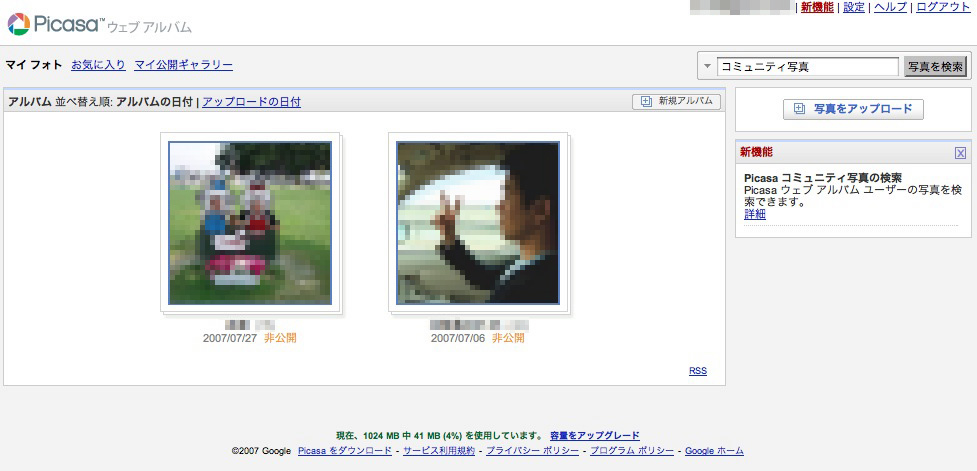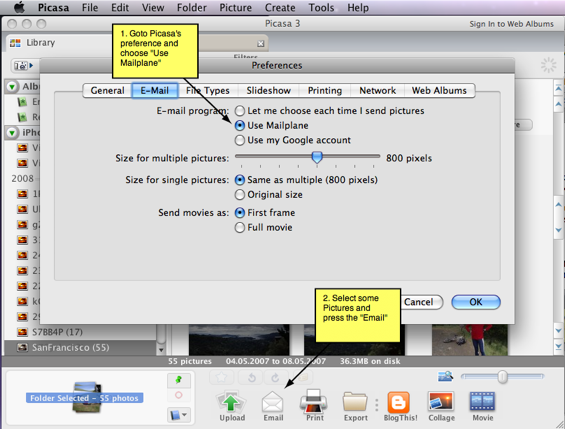Picasa Blog: Announcing Picasa For Mac
. Windows: 3.9.141.259 (9 October 2015; 3 years ago ( 2015-10-09)). Mac: 3.9.141.306 (9 October 2015; 3 years ago ( 2015-10-09)), Website Picasa is a and for organizing and editing, plus an integrated, originally created by a company named Lifescape (which at that time may have resided at ) in 2002.
In July 2004, Google acquired Picasa from Lifescape and began offering it as. 'Picasa' is a of the name of Spanish painter, the phrase mi casa (Spanish for 'my house') and 'pic' for pictures. Native applications for, and (Intel only) were available from Google. For, Google bundled with the Windows version to create an installation package. For Mac OS X 10.4 and later, Google also released an plugin and a standalone program for uploading photos. On February 12, 2016, Google announced it was discontinuing support for Picasa Desktop and Web Albums, effective March 15, 2016, and focusing on the cloud-based as its successor. Picasa Web Albums, a companion service, was closed on May 1, 2016.
(KIPI) export to Picasaweb Since June 2006, Linux versions have become available as free downloads for most distributions of the operating system. It is not a native Linux program but an adapted Windows version that uses the libraries. Google has announced that there will be no Linux version for 3.5.
Currently, Google has only officially offered Picasa 3.0 Beta for Linux. On April 20, 2012 Google announced that they were deprecating Picasa for Linux and will no longer maintain it on that operating system. To use latest version of Picasa on Linux, Linux users can use and install Picasa for Windows. Linux users can use other programs to upload to Picasa Web Albums, including. Mac OS X On January 5, 2009, Google released a beta version of Picasa for Mac (Intel-based Macs only). Also, a plugin is available for iPhoto to upload to the Picasa Web Albums hosting service.
There is also a standalone Picasa Web Albums uploading tools for OS X 10.4 or later. The Picasa for Mac is a release. Features. This section needs additional citations for. Unsourced material may be challenged and removed. (August 2009) Organization and editing For organizing photos, Picasa has file importing and tracking features, as well as, facial recognition, and collections for further sorting.
It also offers several basic photo editing functions, including color enhancement, reduction,. Other features include slide shows, printing, and image timelines. Images can also be prepared for external use, such as for e-mailing or printing, by reducing file size and setting up page layouts.
There is also integration with online photo printing services. Other simple editing features include adding text to the image. Picasa supports Google's image format as well as the format and most (RAW files). A user can view and edit RAW files and save the finished edit (as JPG, or other forms) without any changes to the original RAW file. Keywords Picasa uses picasa.ini files to keep track of keywords for each image. In addition to this, Picasa attaches (IPTC) keyword data to JPEG files, but not to any other file format. Keywords attached to JPEG files in Picasa can be read by other image library software like,.

According to the Picasa Readme, Picasa can parse (XMP) data. However, it cannot search local files for existing XMP keywords. Searching Picasa has a that is always visible when viewing the library. Searches are live, so that displayed items are filtered as one types. The search bar will search filenames, captions, tags, folder names, and other metadata.
Picasa also has an experimental feature that allows searching for images that contain certain colors with the 'color' operator. Viewing Picasa has no separate view window. There is only an 'edit view' with a viewing area. Fullscreen view is available in slideshow mode, by holding down the ctrl+alt keys while in 'edit view', or by pressing the Alt Gr key.
This feature is also available through the context menu of Windows Explorer, and provides a way to start the Picasa editor as well. Backup In Picasa 2 and earlier versions, changes to pictures made in Picasa overwrite the original file, but a backup version of the original is saved in a hidden folder named 'Originals' in the same folder as the original picture (.picasaoriginals on Mac OS X). In Picasa 3, changes to pictures made in Picasa are saved to a hidden file picasa.ini in the same folder as the original picture.
This allows multiple edits to be performed without altering the original image. Viewing the picture in Picasa or using the Picasa Photo Viewer will apply modifications on the fly, whereas viewing through other programs (such as Windows XP's Photo and Fax Viewer) will display the original image. Changes can also be made permanent using the 'Save' function, where the original file is backed up in a hidden folder.picasaoriginals located in the same folder as the original picture and the modified version is written in its place. Face recognition On August 15, 2006, Google announced it had acquired Vision, whose technology can be used to search for features within photos such as people or buildings. Google applied this technology for, and this functionality was launched on Picasa Web Albums on September 2, 2008.
Neven Vision incorporates several patents specifically centered around face recognition from digital photo and video images. Geotagging Since June 2007, Picasa can write geographic coordinates to metadata, thus an image. Since version 3.5 of PicasaGeotagging may be done directly inside Picasa. The geotagging functionality is described in the Picasa User's Guide. Other Picasa applications Picasa Web Albums.
Main article: Besides, Picasa also integrates with, an and web service. The service allows users with a to store and share their photos on the service. Users with a Google+ account receive unlimited storage for photos of a resolution less than 2048x2048 pixels; all others receive unlimited storage for photos of a resolution less than 800x800. Hello Hello by Google's Picasa was a free computer program that enabled users to send images across the Internet and publish them to their. It was similar to an program because it allowed users to send text, but Hello focused on.
Users could opt to view the same pictures as their friends in real-time. One of the advantages claimed at the website is that photos could be shared through firewalls. The service was canceled at the end of 2006, and users were instructed to try the Picasa 'Blog This' functionality for uploading pictures to their blogs. According to the official website, the Hello project was shut down on May 15, 2008. Discontinuation On February 12, 2016, Google announced that the Picasa desktop application would be discontinued on March 15, 2016, followed by the closure of the Picasa Web Albums service on May 1, 2016.
Google stated that the primary reason for retiring Picasa was that it wanted to focus its efforts 'entirely on a single photos service' the cross-platform, web-based. While support for the desktop version of Picasa is ending, Google has stated that users who have downloaded the software, or who choose to download it prior to the March 15th deadline will still be able to use its functionality, albeit with no support from Google. See also. References. Imaging Resource. Retrieved 2016-05-03.
Picasa Resources. 9 October 2015. Retrieved 9 October 2015. By Michael R.
Tomkins, The Imaging Resource (Monday, November 18, 2002 - 15:49 EST). Published on imaging-resource.com under 'Comdex Fall 2002 Show'. ^ 'Google Picasa', Obsessable (obsessable.com), 2009. Squires, Michael (September 3, 2008).
Picasa Photo Editor
Retrieved February 15, 2016. Retrieved 2016-02-13.
ELYSE BETTERS, Pocket-Lint. Retrieved Jan 26, 2017. Retrieved 2012-03-12. October 11, 2011. Retrieved 2011-12-10.
Claburn, Thomas (2009-09-22). Retrieved 2011-12-10.
Google Official Blog. Retrieved 2012-04-23. Retrieved 2011-12-10. Retrieved 2013-01-10.
Jonathan Seff, MacWorld. Retrieved March 3, 2017. January 5, 2009. Retrieved 2009-11-12. Archived from on 2009-02-04.
Retrieved 2010-11-23. Sabharwal, Anil. The Official Google Picasa Blog.
Retrieved 12 February 2016. Sabharwal, Anil. Retrieved 12 February 2016. External links Wikimedia Commons has media related to.
Google the now have available for download. Well, MacWorld 2009 is currently underway – so that is why they released it this week. What took so long for Google to bring Picasa to the Mac? I am not sure.
Google had a Picasa Web Albums and an for Mac users but never the application. The Wired Blog has the of many features available in Picasa. Below I will also embed a video demonstration of Picasa for Mac. As many of you know, I am a long time Mac user. I personally have been using iPhoto with Flickr.
I plan on giving Picasa a try, since it won’t really impact my iPhoto or Flickr albums. I am particularly eager to try the, amongst other features – but I am sure it will take a lot to move me off Flickr and onto Picasa completely. More coverage on this release can be found at. Postscript: A few hours later, I check out some of the of MacWorld and I see Apple has added tons of features, including the face recognition feature I was looking for in Picasa, to iPhoto.
Picasa Free Download For Mac

So maybe I won’t bother switching or testing Picasa.